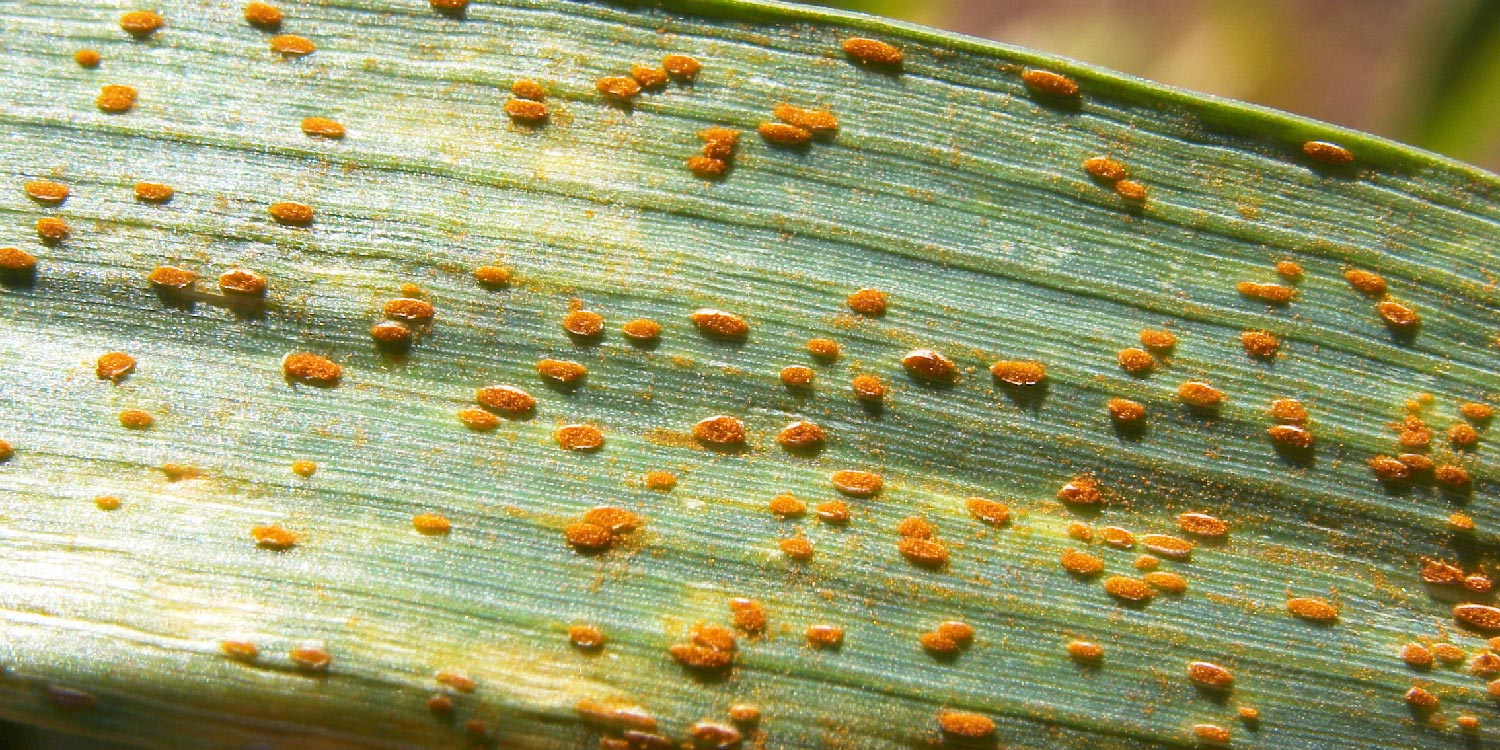Wheat rusts are fungal diseases that affect wheat in almost every country in which wheat is grown causing the most significant economic losses.
With the capacity to form new strains of fungus, rusts can attack even previously resistant varieties.
The infectious spores of rust fungus have the ability to spread and travel long distances by dispersal of wind and can rapidly cause infections under optimal weather conditions.
There are three rust diseases affecting wheat. These are
- Leaf rust – attacks the foliage
- Stem rust- forms on stems and leaf sheaths, although they may form on awns, glumes and seeds.
- Stripe rust- occurs on leaves, although glumes and awns may also be affected.
Leaf rust
It is also known as brown rust and is caused by the fungus Puccinia triticina.
Symptoms due to infection are dusty, reddish-orange to reddish-brown fruiting bodies that appear on the leaf surface. The lesions produce numerous spores, which can cover nearly the entire upper leaf surface.
Leaf rust causes the most damage when severe rusting covers the upper leaves before flowering. Early defoliation may occur, reducing time for grain filling and leading to the creation of smaller kernels. Grain shrivels, and nutrients produced, majorly in the flag leaf, are used by the fungal infection instead of being transported to the grain.
Early infection may result in weak plants, poor root and tiller development and significant yield losses can occur.
Leaf rust spores are spread by wind and splashing water.
The optimal environmental conditions for development of infection are temperatures ranging from 59 to 70 degrees F and at least 6 hours of moisture on the leaf surface and new symptoms develop in about 10days with wet and optimal temperatures.
Stem rust
It is also known as black rust and is caused by the fungus Puccinia graminis f. sp. tritici.
Stem rust spots appear elliptical and differ from leaf and stripe rust in that they are more elongated. These spots form on both lower and upper leaf surfaces and are orange to dark-red in color. The margins on stem rust spots are ragged.
Young pustules release numerous spores and later in the growing season, the spores become dark colored, hence the common name of black rust.
With severe infections, the disease can turn a healthy crop into a tangle of black stems only weeks away from harvest, resulting in shriveled grain.
Stem rust development requires the warmest temperatures of the three wheat rusts, ideally 59 to 84 degrees F and 6-8 hours of moisture on the leaf surface and with wet weather and optimal temperatures, new lesions are formed in 7-10 days.
Spores are produced in multiple cycles during the growing season.
Stripe rust
It is also known as yellow rust and is caused by the fungus Puccinia striiformis f. sp. tritici.
Infection produces yellow or orange blister-like pustules that run parallel with leaf veins. The lesions produce massive amounts of spores that are easily dislodged and dispersed by wind.
Severe infections with stripe rust can cause up to 100% crop loss in susceptible varieties if the disease begins early in the season under wet, cool weather conditions.
The spores may leave orange dust on the clothing of individuals walking through heavily infected fields.
In lower humidity, stripe rust spores disperse more freely into the air and can travel to long distances.
Stripe rust appears earlier in the season because development is enhanced by the cool, moist weather early in the growing season.
Disease develops under ideal temperatures of 45 to 54 degrees F with 6-8 hours of leaf moisture.
Several cycles of spore production occur throughout the growing season.
Management Strategy
In order to prevent/reduce losses attributed to infections with wheat rusts, several methods are employed.
Timely control of the disease is very crucial.
Chemical control
The following fungicides are recommended for use in prevention and eradication of bean rust.
- JUPITER 125SC 15ml/20l
- BRADLEY 500SC 10mk/20l
- DOMAIN 250EC 10ml/20l
- DUCASSE 250EW 20ml/20l
- EXEMPO CURVE 250SC 15ml/20l
- EXPLORER 3SL 10ml/20l
- MILESTONE 250EC 10ml/20l
- MILLIONAIRE 690WDG 40g/20l
- PROVIDENCE 400WP 50g/20l
- RANSOM 600WP 15g/20l
- TOMAHAWK 250EC 10ml/20l
- TRINITY GOLD 425WP 50g/20l
- COLONIZER 440WP 50g/20l
- DEFACTO 500EC 20ml/20l
- ABSOLUTE 375SC 10ml/20l
Non-chemical control
- Crop rotation with non-host plants or members of Gramineae family
- Maintenance of field sanitation/hygiene, for example, removal of debris which are a main source of inoculums helps in reducing infections to successive crops
- Planting resistant/tolerant varieties
- Proper weed management
- Planting certified/disease free seeds
Note;
- Fungicides should be mixed with INTEGRA 3ml/20l to ensure effective coverage, this is a sticker, spreader and penetrant.
- Alternating different fungicides within a crop season is helps to prevent the pathogen from gaining resistance towards any of the fungicides.
- A proper nutrition increases plant resistance to infections.






